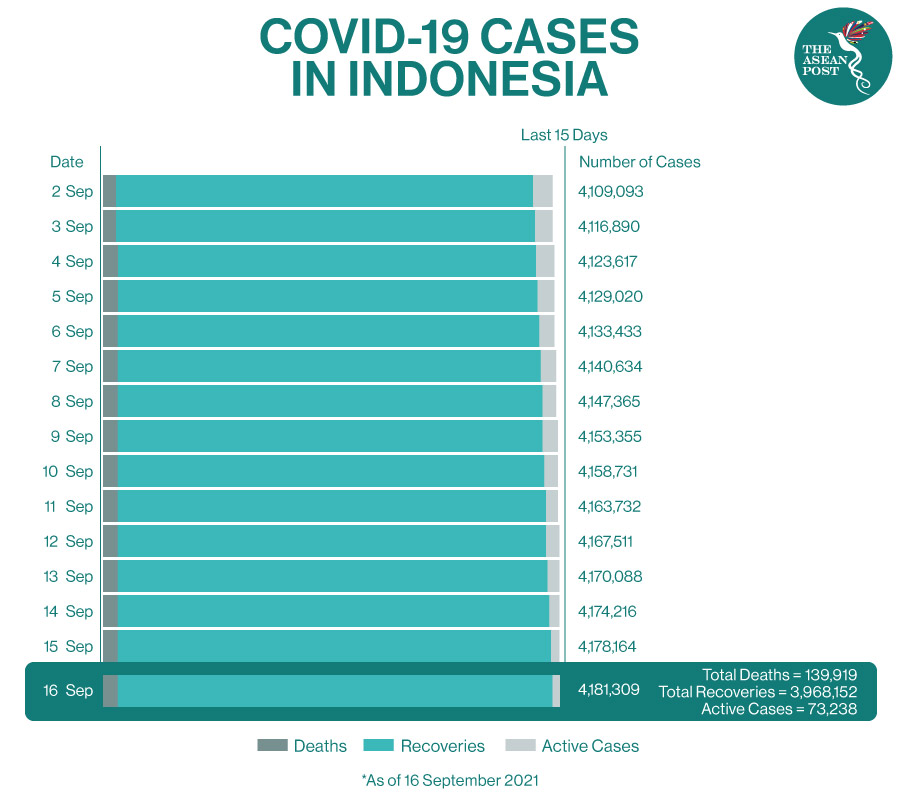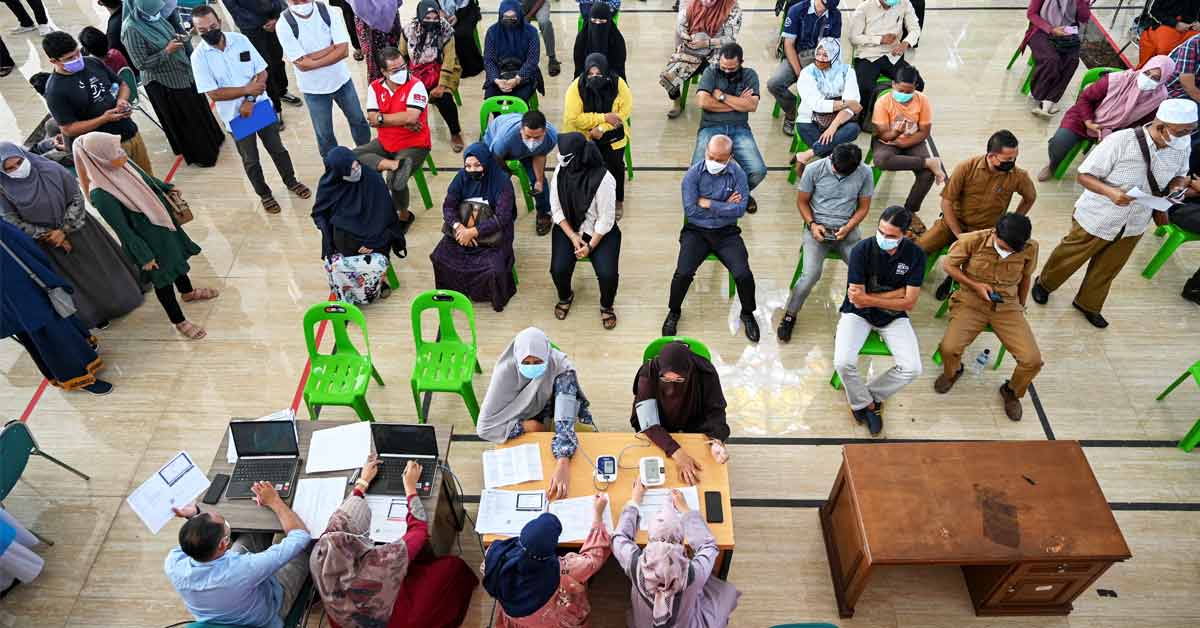Official data in Indonesia shows a Delta-driven second wave of COVID-19 that saw the Southeast Asian nation become the global epicentre of the pandemic in July and August has run its course.
But some of the country’s top epidemiologists say poor testing and tracing capacity, inaccurate estimates on the death toll and the deliberate falsification of data, means there is still no clear picture of the pandemic in Indonesia and a third wave could be brewing.
At the peak of Indonesia’s second wave in July, a staggering one in three people tested for COVID-19 in the country showed a positive result.
But the seven-day average positivity rate has now dropped to 3.64 percent and is still falling, according to the National Board for Disaster Management. It is the lowest positivity rate the country has reported since the start of the pandemic and a number that lies well within the 5-percent benchmark the World Health Organization (WHO) uses as an indication that countries with control of the virus.
Indonesia’s daily cases - which reached a peak of 56,757 new cases on July 15 and saw hospitals bursting with patients on the most densely populated island of Java - stood at 3,948 on Wednesday (15 September 2021). Meanwhile, the official number of daily fatalities, which surpassed 2,000 in July, tumbled to 267 on the same day.
“The second wave in Indonesia seems history,” said Udayana University professor Gusti Ngurah Mahardika, the most senior virologist in Bali, where daily confirmed case numbers fell from more than 1,500 last month to 182 on Wednesday.

Testing And Tracing Problems
Mahardika, who last year told Al Jazeera there was “no transparency of data” in Indonesia says “the data is much better than even a month or two ago”. But he adds that it is still unreliable because the average number of close contacts traced after an individual produces a positive test result is “less than five and sometimes zero”. According to the WHO, a minimum of 15 close contacts should be traced and tested whenever a person tests positive for COVID-19, but the optimum is 30.
Mahardika also criticised the government’s ongoing use of “substandard” rapid antigen tests in place of “gold-standard” pfanonolymerase chain reaction or PCR tests: “If all specimens were tested using PCR, more positive results would be revealed.”
Kawal COVID-19, an independent data initiative in Jakarta, agrees. Its data shows that among the 98,900 people tested with rapid antigen tests on Monday, only one percent showed a positive result. Among the 21,700 people tested with PCR tests on the same day, 7.6 percent were positive.
“Antigen tests are not as accurate as PCR tests as they have a smaller window to show positive cases,” said Septian Hartono, a medical scientist and data coordinator for Kawal COVID-19. “If we were to perform all the tests with PCR, we are going to get a larger number of cases. But the downward trend the official data shows is still accurate.”
Hartono believes the situation in Indonesia is similar to India, where there was “a very sharp increase and a very sharp decrease because the Delta variant ran out of fuel.”
“The reproduction rate for Delta was originally six to eight but emergency restrictions reduced it. Another thing that reduced it was the high number of people that were infected because once a person is infected they have much less risk of being infected again. The reproductive rate has now dropped to three or four, similar to the Alpha variant,” he says.
Deaths At Home
Dr Dicky Budiman, an epidemiologist who predicted Indonesia’s second wave a month before its peak, credits the government for making “some progress” in suppressing the pandemic.
“I am pleased with what is happening in Jakarta and some other cities on [the main island of] Java where officials there are diligent and their data is transparent,” he said.
But outside of Java, he says, it is a different story: “The trend for new cases in Indonesia has moved from cities to villages and from Java to outlying islands where they don’t have enough capacity for testing. Most of these areas have performed poorly for one-and-a-half years but then suddenly in two months, they’ve shown a major improvement. This is the reason I am not convinced by their data.”
An epidemiologist advising the ministry who spoke on condition of anonymity because they are not authorised to speak to the media, said to claim the data outside of Jakarta was unreliable was a “massive understatement”.
“Jakarta is the only government doing their very best to gather and present data,” they said. “Most provincial governments are incompetent in that they are not doing a very good job in terms of data collection while one or two are actually doing their best to hide the data so their provinces don’t get locked down.”
Budiman adds that the drop in the national positivity rate also reflects the falling use of PCR tests: “PCR testing has decreased from about 60,000 per day to about 20,000 per day in the first week of September, which is very worrying in a country with a huge population like Indonesia,” he said, citing the most recent WHO coronavirus situation report on Indonesia.
Budiman says Indonesia’s official death toll is also inaccurate because the government’s definition of a coronavirus death does not follow WHO guidelines. “They only include victims who died and who received a positive response from a PCR test,” he said. “This is a narrow definition and supports my conclusion that Indonesia is not yet producing the kind of clear and convincing data needed to show it has control over the pandemic.”
Hartono concurs: “From June to August, the official fatality rate for COVID-19 in Jakarta was 6,000. But in the same period, 18,000 excess deaths were recorded in the city because there were thousands of people who died at home without being tested as they couldn’t even get to a hospital.”
Ministry of Health spokeswoman Dr Nadia Wikeko denied testing numbers were decreasing and told Al Jazeera that Indonesia has a narrower definition of a COVID-19 death “because we want to confirm the cause of death and get the valid data.”
A Third Wave?
A conservative, poorly organised, corruption- and flood-prone archipelagic nation home to the world’s fourth-largest population, vaccinating Indonesia was never going to be easy. To date, only 20 percent of the target adult population of 181.5 million is fully vaccinated with a further 35 percent partly vaccinated. This begs a question: is a deadly third wave looming on the horizon in Indonesia?
Using a pattern that shows the coronavirus peaking in Indonesia every six months, Udayana University’s Mahardika says the next wave could strike in January. But “it doesn’t matter if cases re-explode,” he said. What matters is “will vaccines be effective in curbing hospital admissions and fatalities.”
China’s Sinovac vaccine is the most commonly used jab in Indonesia, which took part in late-stage trials for the drug. The latest large phase-three trial in Brazil showed the Chinese-made vaccine had an efficacy rate against symptomatic cases of 51 percent, compared with 76 percent for AstraZeneca and well above 90 percent for the Pfizer and Moderna mRNA vaccines.
Medical experts agree that any vaccine is leagues better than none at all, but Indonesia is hedging its bets by giving at least eight million Moderna booster shots to pregnant women and medics, as well as millions more people Pfizer and the AstraZeneca shots donated by foreign countries.
Kawal COVID-19’s Hartono says a third wave can be prevented in Indonesia if the government conducts an enormous nationwide “seroprevalence” study: “Seroprevalence testing tells us the total number of people who have been infected and the number of people that have been vaccinated and there will be some overlap of course. Based on estimates that 40 percent to 50 percent of the country has been infected, I believe the seroprevalence rate in Indonesia is about 60 percent.”
With this data in hand, Hartono explains, the government will have a clear picture of the pandemic and can use it to make a data-based decision on whether to further ease restrictions introduced in July. “The central government is traumatised by what happened in Indonesia so they are now doing things in a very careful manner,” he said. “But if they lift all the restrictions, the rate will go up again.”
Dr Wikeko at the Ministry of Health said the government can accurately predict and is prepared for a potential third wave but will need “the support and collaboration of the people” to tackle it effectively.
But her colleague at the ministry who wanted to remain anonymous told Al Jazeera nothing could be further from the truth: “If the next wave is as big as the one we had in July, I don’t think the country is any better prepared.”
He adds: “I am not saying the government is doing nothing. The ministry is very energetic and pushing to increase tracing and testing. But the fact is we have very limited ability to influence provincial governments in Indonesia. We can only issue regulations. We have no power to enforce them.” – Al Jazeera
